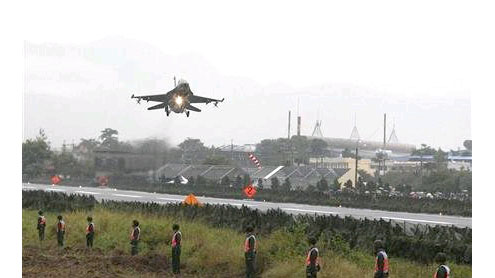 WASHINGTON : Booming Middle East purchases of U.S. fighter jets will be a bright spot in what is expected to be a sluggish economy in 2012, possibly paying dividends for President Barack Obama’s bid for a second term.
WASHINGTON : Booming Middle East purchases of U.S. fighter jets will be a bright spot in what is expected to be a sluggish economy in 2012, possibly paying dividends for President Barack Obama’s bid for a second term.
Beneficiaries include Lockheed Martin Corp and Boeing Co, whose respective F-16 and F-15 production lines are being extended by U.S. government sales to Iraq, Saudi Arabia and Oman, among other rich arms deals announced in recent weeks.The foreign sales will help offset expected cuts in big-ticket purchases by the Defense Department, which is set to lose at least $450 billion in previously projected funding through 2021 as part of a deficit-reduction push. Additional cuts totaling another $500 billion to $600 billion over the same period are scheduled to kick in next year unless a new deficit-reduction plan is adopted by Congress.
The sales of fighters, missiles and other advanced U.S. weapons will help provide jobs as the United States heads into an election campaign expected to focus on the domestic economy. It has been growing at only half the pace needed to get the jobless rate down from 8.6 percent, a problem for Obama as the incumbent.The Obama administration announced last week it had finalized a record $29.4 billion Boeing F-15 sale to Saudi Arabia, dwarfing previous individual U.S. arms deals and supporting jobs by increasing exports.
Deliveries of 84 of the most advanced F-15 fighters are expected to start in 2015 with upgrades to 70 others expected to start in 2014, the administration said. Congress had cleared the sale in the fall of 2010, setting the stage for the freshly completed negotiations on the government-to-government contract.Josh Earnest, a White House spokesman, portrayed the deal as shoring up Saudi air defenses in a region rattled by Iran’s disputed nuclear program as well as supporting more than 50,000 U.S. jobs at a time of high unemployment.The deal was signed December 24 and unveiled by the White House on Thursday in Hawaii, where Obama has been vacationing.
The program involves roughly 600 suppliers in 44 of the 50 U.S. states and give the economy a $3.5 billion annual boost, Assistant Secretary of State for Political-Military Affairs Andrew Shapiro told reporters at a State Department briefing.”This will support jobs not only in the aerospace sector but also in our manufacturing base and support chain, which are all crucial for sustaining our national defense,” he said.The deal is worth about three times more than any other single U.S. arms sale to date, according to a March 10 report on U.S.-Saudi ties by Christopher Blanchard of the nonpartisan Congressional Research Service.
It will extend Boeing’s F-15 production line about five years to late in this decade, Dennis Muilenburg, head of the company’s military, space and security business, said in a telephone interview with Reuters.”Having that hot production line gives us the base to invest in technology advancements for that platform going forward, he said. “Obviously, that creates a lot of momentum for us on our international growth.”Workers on the F-16 fighter production line at Lockheed Martin’s Fort Worth, Texas plant also have received good news for their job prospects. The Defense Department awarded Lockheed a $600 million contract on December 14 to build 12 late-model F-16s for Oman, the second firm order in two weeks.
Lockheed received an $835 million Pentagon contract on December 5 to build 18 F-16C/Ds for Iraq. Only months earlier, the company, the Pentagon’s No. 1 supplier by sales, had warned it would have to start shutting down its supplier base by year end absent new F-16 orders.On top of the contracts for Iraq and Oman, the Obama administration told the U.S. Congress on December 12 that it was proposing to sell Iraq another 18 F-16s, advanced munitions and related gear for an estimated $2.3 billion. Analysts have questioned whether adding U.S. arms into Iraq could heighten growing sectarian tensions there since the U.S. completed its troop withdrawal last month.
Fighter jets are not the only pricy arms deals, long in the works, to have been brought to a conclusion by the Obama administration as the president prepares to swing more into campaign mode. On Friday, the Defense Department said the United States had reached a $3.5 billion agreement to supply an advanced antimissile interception system to United Arab Emirates.The U.S. Congress had been notified of the proposed sale of the Lockheed Martin system – known as Theater High Altitude Area Defense — in September 2008 by former President George W. Bush’s administration.
Lockheed and its supporters had sought to play on the election calculus in pushing to meet Taiwan’s request, over China’s objections, for 66 new F-16C/Ds valued at more than $8 billion.Pushing the sale in October, Rupert Hammond-Chambers, president of the U.S. Taiwan Business Council, a trade group that includes Lockheed, wrote that F-16 associated jobs “could have an important positive impact on local communities around the country – particularly in California, Connecticut, Florida, Maryland, Ohio, Texas and Utah,” possible electoral swing states.
But the Obama administration, apparently in an effort to placate Beijing, has been unwilling to meet that request. Instead, the president offered a $5.3 billion upgrade of Taiwan’s 145 existing F-16A/Bs.F-16s played a role in a previous U.S. election. George H.W. Bush announced during the 1992 presidential campaign that he would sell Taiwan 150 of the A/B models. He signaled an intent to do so during a campaign rally at the General Dynamics Corp plant then producing them in Texas where jobs had been in danger. – Yahoonews












